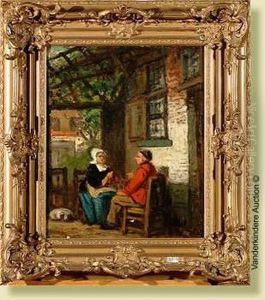Adrien De Braeckeleer Paintings
Adrien De Braeckeleer was a Belgian artist born on July 16, 1818, in Antwerp. He belonged to a prominent family of artists and was the nephew of Ferdinand de Braekeleer the Elder, a well-known painter, and the cousin of Henri de Braekeleer, another respected artist of the time. Coming from such an artistic lineage, it was natural for Adrien to take up the profession of art.
During his lifetime, De Braekeleer was primarily known for his genre paintings, which depicted scenes of everyday life with a particular emphasis on the customs and costumes of the Flemish people. He was also known for his historical paintings and his works that captured public events and gatherings. His style was characterized by a detailed and vivid portrayal of his subjects, often infused with a sense of humor and a warm, vibrant color palette.
Adrien De Braeckeleer was part of the Romantic movement that was prevalent in European art during the first half of the 19th century. This movement was a reaction against the strict rules of academic painting, and it emphasized emotion, individualism, and a glorification of the past, particularly the medieval period. De Braeckeleer's works often reflected these Romantic sensibilities.
Despite his family's significant artistic reputation, Adrien never achieved the same level of fame as his uncle or cousin during his lifetime. Nevertheless, his works were appreciated for their charm and historical value. Today, his paintings can be found in various museums, and they offer insights into the cultural life of 19th-century Flanders.
Adrien De Braeckeleer lived through a period of significant change in Belgium, which had gained its independence in 1830. The country was experiencing cultural and political shifts, and there was a growing interest in establishing a national identity, which is reflected in the subject matter of many Belgian artists of the time, including De Braeckeleer.
De Braeckeleer passed away on January 4, 1904, leaving behind a body of work that, while not as widely recognized as some of his contemporaries, contributes to the rich tapestry of Belgian art history and offers a window into the world of 19th-century Flanders. His paintings continue to be of interest to art historians and collectors who are captivated by the Romantic era and Flemish cultural history.
